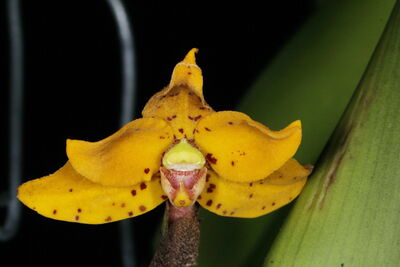-
General Description
-
Epiphytic herbs. Roots from basal part of the stem opposite the leaves. Stem spreading to pendent, sometimes erect, leafy. Leaves distichous, conduplicate, linear, apex unequally bilobed or sometimes acute. Inflorescence pendent, racemose, sometimes erect and paniculate, axillary, 1–4; peduncle and rachis glabrous or covered by stellate hairs, few- to many-flowered. Flowers dimorphic or not; basal flowers, when different from the others, 2–4, yellow, highly scented, unspotted or lightly spotted with red-purple dots; upper flowers (or all flowers in non-dimorphic taxa) blotched or heavily spotted with red-purple or maroon, labellum white to pale yellow, marked with red-purple or maroon. Labellum fleshy, hinged with base of column, trilobed, side lobes erect, oblong to subquadrate, midlobe with a raised, laterally flattened callus and an erect callus at base of larger callus. Column papillose-pubescent or glabrous, with a column foot; anther papillose or not, pollinia four in two appressed pairs, transversely oblong to rounded-obdeltoid, stipe oblong to pandurate, about as long as the pollinia, viscidium elliptic.
-
Ecology
-
Species are epiphytes in forests from 0 to 1300 m. Dimorphorchis lowii and D. rossii Fowlie are mainly found in riverine forests overhanging the water, whereas D. beccarii usually grows as a lithophyte (or semi-terrestrial) on exposed rocky outcrops.
-
Distribution
-
Dimorphorchis is a genus of seven species from Borneo, the Philippines, Sulawesi, New Guinea, and the Solomon Islands. It probably also occurs in the Moluccas. Dimorphorchis s.s., comprising taxa with dimorphic flowers, is endemic to Borneo, with five species and one variety.






